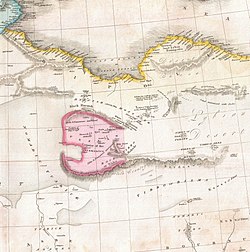Tripolitania
This article needs additional citations for verification. (August 2022) |
Tripolitania طرابلس ( Arabic) | |
|---|---|
 Historical definitions of Tripolitania | |
| Capital | Tripoli |
Tripolitania
The region had been settled since antiquity, first coming to prominence as part of the Carthaginian empire. Following the defeat of Carthage in the Punic Wars, Ancient Rome organized the region (along with what is now modern day Tunisia and eastern Algeria), into a province known as Africa, and placed it under the administration of a proconsul. During the Diocletian reforms of the late 3rd century, all of North Africa was placed into the newly created Diocese of Africa, of which Tripolitania was a constituent province.
After the
After the 1934 formation of Libya, the Tripolitania province was designated as one of the three primary provinces of the country, alongside Cyrenaica province to the east and Fezzan province to the south.
Definition

Historically, the name Tripoli designated a region rather than a city, just as today in Arabic the same word Tarablus (طرابلس) is used for both the city and the region. The Arabic word used alone would be understood to mean only the city; in order to designate Tripolitania in Arabic, a qualifier such as "state", "province" or "sha'biyah" is required.
The region of Tripoli or Tripolitania derives from the Greek name Τρίπολις "three cities", referring to Oea, Sabratha and Leptis Magna. Oea was the only one of the three cities to survive antiquity, and became known as Tripoli. Today Tripoli is the capital city of Libya and the northwestern portion of the country.
In addition to
.History
Antiquity
The city of Oea, on the site of modern
Middle Ages
In the 7th century, Tripolitania was conquered by the Rashidun Caliphate, and its successors, the Umayyad and Abbasid Caliphates, inherited it.
The
Modern history


After
Originally administered as part of a single colony, Italian Tripolitania was a separate colony from 26 June 1927 to 3 December 1934, when it was merged into Libya. The Italian fascists constructed the Marble Arch as a form of an imperial triumphal arch at the border between Tripolitani and Cyrenaica near the coast.
Tripolitania experienced a huge development in the late 1930s, when the Italian Fourth Shore was created with the Province of Tripoli, with Tripoli as a modern "westernized" city. The Tripoli Province ("Provincia di Tripoli" in Italian) was established in 1937, with the official name being Commissariato Generale Provinciale di Tripoli. It was considered a province of the Kingdom of Italy and lasted until 1943.
During
Tripolitania retained its status as a
.The Modern Latin missionary jurisdiction was called the
